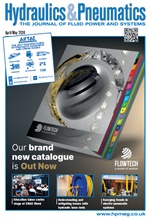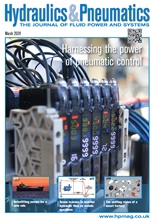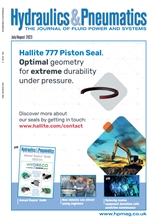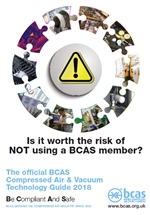Thermo Kit aimed at boosting compressor energy recovery
Atlas Copco is aiming to rapidly increase the adoption of compressor energy recovery with the launch of an all-in-one kit that simplifies integration with a building’s central heating and hot water system. The revolutionary Thermo Kit is a complete package of energy recovery components that can be installed quickly and easily to provide the user with a highly efficient source of supplementary hot water at no additional cost.
Towable compressors are compact, powerful and energy efficient
Providing a dependable, efficient and environmentally-friendly source of quality compressed air in a compact, towable unit are the important benefits of two new portable compressors introduced by HPC Kaeser. Compact and simple to operate, the M114 and M115 portable compressors are both powered by 85kW engines and deliver similar free air deliveries up to 9.7 m³/min (342 cfm) at 10 bar.
Boge saves €60k for leading packaging provider
A world-leading paper-based packaging company has made significant cuts in costs by installing a Boge SLF 125 compressor. The company has estimated that at least €60k per annum is being saved in energy consumption and maintenance since installation.
Training with Beko Technologies
Beko Technologies is offering training days to give people an opportunity to increase their knowledge on a variety of topics including oil-free air, measurement technology, air treatment, condensate management – plus up and coming new products from Beko.
CompAir compressors ensure maximum productivity for TT Solutions & Interiors

TT Solutions & Interiors Ltd., a manufacturer of bespoke and modular furniture, is experiencing greater production reliability thanks to a compressed air system supplied by Gardner Denver (CompAir) distributor, BCAS Limited.
Holroyd at China Refrigeration 2015
Holroyd Precision Components will be showcasing its screw and compressor rotor design, prototyping and manufacturing capabilities at China Refrigeration 2015 – the International Exhibition for Refrigeration, Air-conditioning, Heating and Ventilation – to be held from 8th – 10th April at Shanghai New International Expo Centre.
Chicago Pneumatic launches new portable compressors in Europe

International construction equipment manufacturer Chicago Pneumatic has introduced new versions of its CPS 11.0 (7 bar) and CPS 11-12 (12 bar) portable compressors for the European market. The powerful compressors feature EU compliant Stage 3B engines and a new electronic control panel which is said to make them easy for users to operate, monitor and service.
Metpoint OCV makes the quality of compressed air visible
Metpoint OCV offers precision measurement technology for all industrial sectors, where compressed air plays an important part in the production process and real-time monitoring of compressed air quality is process critical. Even ‘oil-free’ components are no guarantor for ‘oil-free’ compressed air, ambient air/ intake air have a big impact on achieving oil free air. In most cases, a certain residual oil content cannot be entirely avoided in standard applications. Therefore, more precise monitoring of the oil vapour content, which is possible at any time is important. Crucial factor Especially in critical production processes of the chemical and pharmaceutical industry, in food production and surface engineering, the analysis, validation and control of compressed-air quality is a crucial factor. The Metpoint OCV continuously monitors and documents the residual oil content of the flowing compressed air. Even the smallest amounts of oil in the compressed-air will be detected and reliably determined. Time-intensive sampling and costly laboratory analyses are no longer required. The provided data gives early notice on the possible contamination of pipework and products. When critical points are reached in the system, the user is will be able to react immediately to deviations in a proactive manner. The Metpoint OCV thus helps prevent damage to machines and plant, avoids high repair and reject costs and, not least, damage to products and therefore consumer confidence. Key advantages According to Beko Technologies, key advantages of Metpoint OCV include: • Measurement of the residual oil content down to ranges of mere thousandths of mg/m³. • TÜV-certified system in accordance with ISO 8573. • Continuous monitoring, 24/7 process reliability. • High data precision. • Direct indication of deviations, short reaction times. • Network-compatible, with touchscreen display. • Pay back usually within the first year. www.beko-technologies.co.ukMark MSM compressor aids disabled engineering solutions unit
MERU produces a range of disability equipment solutions to meet individual needs. There are many ‘off the shelf’ items in the catalogue, however MERU specialises in the design and build of bespoke equipment for children. While upgrading its production facility, the organisation required an improved compressed air set-up, which led it to Mark Compressors’ Full Feature unit. The installation of a new CNC machine at MERU’s Epsom design offices and workshops, replacing the existing lathes for the milling of metal parts, meant that the quality of air supplied by the old, struggling, piston compressor was just not good enough for the new demands. “The CNC machine needs pure, dry air to operate it,” said Gary Scarlett, chief design engineer and facilities manager. “Therefore, we looked for a compressor and dryer combination which could provide that need.” At the same time it was decided to completely re-spec the compressor to fulfil a number of new requirements. The air-output capacity needed to be increased because there would now be occasions when the CNC machine would be running at the same time as a sandblaster and other air tools. Certain plastic-moulded parts require that there is no moisture contamination and so, once again, the need for dry air was paramount. While 7-8 bar is the constant pressure needed, it was decided to go for a machine with a capacity of 10 bar to cover any contingency situations. The arrival of the CNC machine meant a need for continuous air supply, so reliability became a key issue, since any interruption to the air supply would mean a complete re-set of the task programmed into the CNC. All these points were coupled with a need for a quieter machine, while still retaining a small footprint to suit the area where it was to be located. After looking into a number of options, Scarlett and his team opted for a Mark MSM 4kW DX compressor, including a dryer, integrated as a receiver-mounted combination. This fulfilled all the requirements, giving 100 per cent dry air and a noise level as low as 62 dB(A). As one member of the team remarked, “Compared to the old banging piston machine, we hardly know the Mark compressor is running. It’s a real joy not to have that thumping sound in the corner of our otherwise quiet workshops.” In addition to the specialist design engineering team, the workforce at Epsom is supplemented by both engineering students on work-experience placements and a number of volunteers. MERU was founded in 1973 as a charity by William Bond, a senior lecturer in design engineering, and Trefor Llewelyn- Bowen, consultant orthopaedic surgeon, who were both concerned at the lack of clinical facilities that could provide equipment for disabled children. They saw that some children have disabilities so complex that no available ‘off-the-shelf’ equipment met their needs. Working towards providing answers to these problems is still the driving vision at MERU and the organisation works closely in consultation with medical teams, considering individual cases and providing products to meet each specific brief. The result has seen some extremely innovative solutions, among them a powered indoor chair called Bugzi. This allows the severely disabled to move themselves around at an early age, substituting the equivalent of movement that a child would normally have at the crawling or early walking stages of development. Bugzi is one of the main products in evidence when touring the production facility, and it was to meet the demand for increased numbers of chairs that led to the installing of this new range of equipment. However, many other important items have been developed by the team, including travel seats for use on aircraft, arm guards, grab bars and flexible gadget stands, which allow perfect positioning of a device, such as a phone or iPad. www.markcompressors.comChicago Pneumatic launches new portable compressors in Europe
International construction equipment manufacturer Chicago Pneumatic has introduced new versions of its CPS 11.0 (7 bar) and CPS 11-12 (12 bar) portable compressors for the European market. The powerful compressors feature EU compliant Stage 3B engines and a new electronic control panel which is said to make them easy for users to operate, monitor and service. Built for tough construction and maintenance applications, the CPS 11.0 and CPS 11-12 portable compressors are perfect for surface drilling, abrasive blasting and ice blasting, and excel in road work and shotcrete pumping. The 12-bar variant is also suitable for special applications such as fibre optic cabling, with the higher working pressure enabling the CPS 11-12 compressor to push cabling through longer pipeline distances without incurring pressure loss. Deutz engines The CPS 11.0 and CPS 11-12 compressors feature new Deutz engines which are fully compliant with EU Stage 3B emission standards. The compressors’ powerful engine uses Exhaust Gas Recirculation technology in combination with a Diesel Oxidation Catalyst and, for the CPS 11-12 a Diesel Particulate Filter, to sharply reduce the output of particulate matter and nitrogen oxides. As a result, the CPS 11.0 and CPS 11-12 are more environmentally friendly than previous models and provide operators with the benefit of increased fuel efficiency at partial load. Central controller Another major new feature is the easy-to-use central electronic controller thatprovides operators with an improved user interface and straight forward control and monitoring options. The electronic controls also make it easy for operators to quickly start and stop the compressor and regulate automatic cool-down after the unit has been running at full load. With large 175 litre fuel tanks the CPS 11.0 and CPS 11-12 compressors provide operators with outstanding fuel autonomy that enables the compressors to be run non-stop at full load for an entire shift without refueling. A fully automatic step-less speed regulator also means the engine speed can be adapted to air demand. Additional options include a braked undercarriage with a fixed or height adjustable tow bar, a non-braked undercarriage with fixed tow bar, jockey wheel, leg support and several towing eye options. www.cp.comCompAir helps robot band take to the stage

A CompAir compressor supplied by BCAS Limited. has helped a band made up of three, 5ft tall robots take to the stage at a recent festival in London. The band’s members are all built out of scrap metal and are controlled by electro-pneumatics. Some of the most popular tracks performed by the band have been viewed more than 6.3 million times on YouTube. Constant flow of air The 11kW compressor supplied by BCAS Limited, a distributor of Gardner Denver products including the CompAir brand, provided a constant flow of compressed air to the band throughout their performance at the festival. Louisa O’Connor, senior project manager at creative production company, DesignScene, which designed and produced a bespoke structure for the London festival, commented: “Without compressed air none of the robots in the band can perform, so it was vital that the compressor we used could provide a constant flow of air. BCAS Limited supplied and installed the compressor on time, with the CompAir unit performing reliably throughout, ensuring the band could entertain the tens of thousands of fans who attended the three day festival.” The new design of the high efficiency air end in the CompAir L11 compressor operates at low rotational speeds, resulting in lower energy costs, whilst the unit’s IP55 motor provides operational reliability. Designed to pass through a standard doorway, the L11 is simple to install and low noise levels mean the compressor can be located close to the application. The L11’s integrated design, with oil separation, oil filter and thermostatic bypass valve also reduces the number of external hoses and components, resulting in increased reliability. www.compair.com
HPC helps to turn the wind turbine into the finished article
Mabey Bridge is a specialist supplier of high quality steel bridging, tubular structures and heavy plated steelwork which has helped to shape infrastructure development in the UK and around the world. Based in Chepstow, Monmouthshire, just a ‘stone’s throw’ from the Severn Bridge, Mabey Bridge is proud of its 165 years of design and engineering tradition and enjoys a reputation for innovation in engineering and in particular, bridge building. Working in partnership with designers, engineers, contractors and clients in both the public and private sectors, it currently has a production capacity approaching 100,000 tonnes a year. Grand scale In recent years the company has brought its experience and skills to bear on the development of renewable energy projects and the manufacture of on-shore wind turbine towers or, as they are referred to in the industry, canisters. By any measure these manufactured tubular steel structures are big. Depending on the final size of the turbine, the largest produce up to 3.6 megawatts and the smaller turbines generate 235 kW. Each supporting canister is made in either three or four sections, measures up to 36 metres in height, weighs up to 100 tonnes, have a steel thickness of up to 100mm and an overall diameter up to 5 metres. As part of a strategy to further develop its specialist capability for renewable energy manufacturing, Mabey Bridge made a significant investment to add another 30,000 sq ft to its already significant Newhouse manufacturing plant, enabling the production of an additional 100 turbine towers per year. An important part of this expansion was a new, larger fabricating facility to provide surface treatment processes such as blast cleaning using recycled steel grit, through to the final paint finishing stage. A reliable source of quality compressed air is a vital factor in this large scale, industrial manufacturing and finishing process. Prior to the extension project, Mabey Bridge had been impressed with the performance of its original HPC compressed air system, supplied, installed and maintained by HPC Authorised Distributor, Compressor Systems (Wales) Ltd. Ongoing energy efficiency The expansion of the surface treatment facility and the associated scaling-up of the fabricating and finishing processes demanded increased air capacity. However, it was also very important to ensure the ongoing energy efficiency of the system while coping with the new, greater variable demand. A key requirement identified in the early stages of the consultation process was that the compressors for the blast cleaning, paint shop spraying facility and the fabrication area needed to be connected and able to work together. With each system supplying compressed air to the other and depending on the workflow, it needed to be possible to meet a combined varying demand of up to 84.9m³/min (3000cfm). It was also important that the two linked compressed air systems could provide redundancy, and it was essential that the new system ensured that the painting process could always operate uninterrupted. Complementary After carefully considering the options and proposals from several experienced compressed air specialists, Mabey Bridge invested in the knowhow of Compressor Systems (Wales) and HPC Compressed Air Systems. Having worked hard to establish a good working relationship with Mabey Bridge at the company’s other manufacturing sites, Compressor Systems (Wales) was able to demonstrate how the investment in a new variable speed compressor would complement the two existing HPC compressors working with them to optimise efficiency through periods of varying demand. In fact, they were the only supplier that identified and provided a solution to redundancy and for linking the two systems together through the latest HPC compressed air management, control and communication system. The Mabey Bridge compressed air system installed as part of the extension is: 1 off HPC ESD 442 SFC (250kW) rotary screw compressor with SIGMA Frequency Control; 1 off HPC SIGMA Air Manager (SAM) Compressor management, control and communication system; and a compressed air treatment package including refrigerant dryers, compressed air filtration and condensate management. The existing compressed air system at Mabey Bridge comprised: 1 off HPC ESD441 (250kW) rotary screw compressor; 1 off HPC DSD 238 (132kW) rotary screw compressor; and a package of compressed air treatment products. At the heart of the new installation is the HPC SIGMA Air Manager (SAM) management and control system, a powerful industrial PC featuring HPC’s adaptive 3-D control. This state-of-the-art compressed air management system brings together the individual components of the compressed air system to ensure that compressor delivery volume is precisely adjusted to match actual demand (from both the fabrication area and the paint shop) saving energy and reducing operating costs. Unlike other master control systems which are limited by relying on operating within a narrow pressure range and with the lowest possible switching pressure differential, HPC’s 3-D control paints a bigger picture. This ensures unrivalled performance by optimising energy efficiency throughout the entire compressed air system. This level of control and monitoring enables engineers’ at Mabey Bridge to generate and maintain the required levels of compressed air despite the widely varying demands from either the fabrication area or the paint shop, whilst also keeping their kW usage to a minimum. Benefits Commenting on how the new HPC compressed air system has performed, Alex Wilson, production engineer at Mabey Bridge, said: “The variable speed compressor has allowed us to save energy by closely matching the supply and demand of compressed air whilst maintaining an accurate and constant supply pressure.” Wilson continued: The SIGMA Air Manager controls the installation perfectly, switching the compressors in and out to meet the sometimes large variations in demand. We really appreciate the SIGMA Air Manager (SAM) main control feature as it enables our three compressors to work in conjunction providing us with maximum flexibility and directly matching the supply of compressed air with the demand of our processes, whilst maintaining a constant system pressure. It also means that we can add compressors into our system and consider some of the impressive, additional communication and control features of the system as our process needs grow.” The planning, consultation and installation process at Mabey Bridge’s Newhouse site has proved to be a great success and an excellent example of partnership project management and cooperation. The system designed between Compressor Systems (Wales), HPC Compressed Air Systems and Mabey Bridge has reportedly exceeded expectations both in its ability to meet the wide variations in demand for compressed air for the important fabricating and finishing processes and with regard to all-important energy savings. This is another example of HPC’s ability to supply the most energy-efficient compressed air solutions for all industrial markets, whether it is industrial electric, portable diesel units or high volume - low pressure rotary blower systems. www.hpccompressors.co.uk www.mabeybridge.comAPCO ASU combination air valve

DeZurik/APCO/Hilton has introduced the APCO ASU combination air valve, a new concept in air valve technology. This single body combination valve features a patented air release and air/vacuum mechanism that is specifically designed to deal with media containing grit, solids and grease.
Atlas Copco expands workshop to meet rising demand from oil and gas industry

Atlas Copco’s Systems Hemel Hempstead custom engineering workshop has unveiled a £680,000 expansion of its facilities to meet rising global demand from the oil and gas industry. The workshop, which provides bespoke compressed air and nitrogen generation packages directly to UK customers and fulfils international orders on behalf of Atlas Copco companies overseas, has more than doubled in size following the investment.
Open end to atmosphere

At the recent Air-Tech exhibition at the NEC in Birmingham, Beko Technologies gave a presentation about the issues of having an air supply at, for example, 7 bar (g) venting down to atmosphere without doing any useful work or work that cannot be done more economically or safely by another medium… An example of this would be the use of blow guns to clean machinery down at the end of a production period i.e. could be three times per day. This practice was widespread and was wasteful in that the dirt/dust would resettle, the pressure was not often regulated and it is a potentially dangerous practice particularly if the operative has an open sore then compressed air can be potentially lethal. There is a simple answer, use a vacuum attachment to the airline or a ‘venturi’-assisted type which increases the flow at reduced pressure. The opportunities for saving were broken down into 3 key areas. The first was leaks and it is well-known that leaks from a compressed air system can be quite considerable. In fact, a system with 10 per cent leakage is regarded as a good one. Bearing in mind that 10 per cent of all power used in modern industrialised societies will be to compress air then we are wasting 1 per cent of all power even when we are good at housekeeping so it is clearly important that we make sure that the wastage is not significantly higher than this. Causes of leaks What causes leaks in a compressed air system? There are many opportunities for the compressed air network to develop leaks but the principle ones would be: • Corrosive condensate. The particulate material drawn into a compressor together with the small amount of oil carried over will become an acidic liquid when the compressed air cools and water vapour condenses out and mixes. • Poor installation. Pipe supports not adequately deigned causing stress on joints which become leaks. Cheap solutions such as hoses for temporary solutions which become permanent. • Impacts such as fork lift truck. • Poor maintenance. The maintenance engineer has to see the compressed air network as a part of his maintenance routine rather than a one-off occasional exercise to cull leaks. Also some machinery will be stopped at a point where a valve or orifice is open and will remain open until the machinery restarts. These may be small occurrences but the sum total of all these small leaks is normally in excess of 10 per cent and for example a 75kW compressor running on load for a year will cost more than £70,000. Therefore it is important to check leaks via an ultrasonic device, mark up the leaks in some kind of classification as to the severity of the problem then fix the worst ones. It is then important to realise that this is not ‘job done’. The leaks will in some cases come back because of poor installation or appear elsewhere as the corrosive condensate or an impact creates a new leakage. The second area is condensate draining and it is important to understand that the condensate has to be drained efficiently or can be re-entrained and cause moisture problems and as just indicated will create leaks in the distribution system. There are not too many old fashioned steam type traps used anymore because they were subject to blocking through debris falling onto the valve seat and also to hydraulic locking requiring the installation of a balance pipe. Solenoid drains became popular and are still widely used but are inefficient because of the number of variables involved such as compressed air flow, pressure, temperature and relative humidity. All of these combine to ensure that the condensate volumes are different from day to day, morning to evening, winter to summer, UK to China. Product of choice To be sure to get rid of the condensate then the blow down time will be set for the worst case, which will mean considerable wastage on every occasion that does not equate to this set time. The solution to this is the zero loss drain, which is becoming the product of choice because there are no losses of the expensive resource of compressed air. There is an investment cost but in nearly all cases the return on investment can be shown as being acceptable. There may be as many as 100 drain points in a large plant with outdoor piping so it is a simple but important area to consider for the maintenance routine. A customer in the Midlands recently asked Beko Technologiess to attend site because of a perceived drying problem. This problem existed and was being dealt with but as part of the routine checks the air receiver drain was checked. With no exaggeration 15 minutes was required to drain the large air storage vessel. If the condensate level had become much higher than serious amounts of the contaminated condensate would have been re-entrained into their system. The company are involved in an industry where it is vital to be ‘just in time’ and deliver direct to production lines. It is easy to imagine the large scale problems for this company and its customers if a large scale ingress of condensate had occurred. The installation of an efficient level sensing Bekomat solves a potentially disastrous situation at a small investment cost The other area where compressed air is wasted is in the drying process. There are many processes which require a dew point below the -3degC, which refrigeration dryers are capable of reaching. This could be for instrument air, for pneumatic conveying, food, beverage or medical grade compressed air to name a few processes. The lower dew point typically -40degC is achieved by use of a desiccant material which is unchanged by the process of attracting water vapour via molecular forces but will need to be regenerated in order to be used over multiple drying/regenerating cycles. One of the regeneration methods is heatless or cold regeneration which requires a part of the dried compressed air to be expanded to become super dry and then flowed through the wet desiccant bed. Nature does not like large gradients and the difference between the water content of the desiccant and the regeneration air will create the migration across to the compressed air which is then vented to atmosphere. In this method 15 per cent of the compressed air is used solely for drying which if we equate back to our 75kW compressor would mean a cost of £10,000 or more. The reason this genre of dryer was popular was because of low price and simplicity but it is clear that for systems above the 75kW level other methods should be applied. Controlling cost Zero Purge dryers are becoming the norm for larger installations. They use external heat to regenerate the desiccant and blown external air to cool meaning that the costs are kept to a sensible level for the drying process. An example given at Air-Tech was of a company in the automotive industry who had a part purge drying system so lost a smaller notionally 5 per cent of the compressed air but had heating costs and cooling costs. The offer of a zero purge system showed a payback of less than 2 years for the purchase, installation and commissioning of 4 large Beko FRA-V dryers. Ongoing annual savings of more than £250,000 where attractive but another important customer benefit was that they could abandon their plans to add another large compressor into their network. This would have been very costly because alongside the capital and running costs there would have to have been a large investment in creating a space suitable for a large compressor to add to their very large system. Users of oil free compressor should also the consider the use of ‘Heat of Compression’ types of dryer which take advantage of the higher temperatures generated in s dry compressor as opposed to an oil lubricated type, to use the heat for regeneration of a desiccant. The message is clear and simple. Compressed air is the 4th utility but it is expensive and should be used selectively. When looking at energy saving possibilities the factory engineer should be serious looking and thinking “Have I got these open ends to atmosphere?” If the answer is yes then an action plan to reduce or eliminate should be high on his agenda. www.beko-technologies.co.uk
-
Smart Manufacturing & Engineering Week
05 - 06 June, 2024
NEC, Birmingham -
HILLHEAD 2024
25 June, 2024, 9:00 - 27 June, 2024, 16:00
Hillhead Quarry, Buxton, Derbyshire UK









